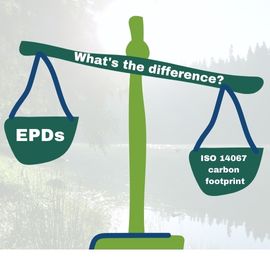What’s the difference? EPDs vs ISO 14067 carbon footprint
14th Mar 2023
What are the main differences between an EPD and an ISO 14067 product carbon footprint study?
 An Environmental Product Declaration (EPD) is a standardised way of communicating the environmental performance of a product over its life cycle, based on life cycle assessment (LCA) data. EPDs are standardised by ensuring they follow a specific set of Product Category Rules (PCR). PCRs are more specific guidelines for conducting an LCA and reporting the results in an EPD for a particular product category. EN 15804 is a common basis for PCRs for construction products for example.
An Environmental Product Declaration (EPD) is a standardised way of communicating the environmental performance of a product over its life cycle, based on life cycle assessment (LCA) data. EPDs are standardised by ensuring they follow a specific set of Product Category Rules (PCR). PCRs are more specific guidelines for conducting an LCA and reporting the results in an EPD for a particular product category. EN 15804 is a common basis for PCRs for construction products for example.
ISO 14067 is the international standard for developing a carbon footprint of a product, providing guidelines for the quantification and communication of the carbon footprint of a product throughout its life cycle, including the entire supply chain.
An EPD provides a comprehensive report of a product’s environmental performance, including the carbon footprint, whereas an ISO 14067 carbon footprint study quantifies and reports only the carbon footprint of a product.
EPDs and ISO 14067 carbon footprint studies are based on the foundation standards of LCA ISO 14040 and ISO 14044 with the same four main phases of an LCA; Goal and scope definition, Life Cycle Inventory analysis (LCI), Impact assessment (LCIA) and Interpretation. The key differences are in how these LCA phases are carried out.
EPDs follow a more prescriptive set of rules to ensure that the results are comparable for products within the same product category. These PCRs (such as those based on EN 15804) provide more detail on how the background LCA study should be conducted and what should be included in the EPD.
If you take a construction product as an example, the study must meet the requirements of ISO 14040 and ISO 14044, ISO 14025, the General Programme Instructions (GPI) of the EPD program, and a PCR for Construction Products as published by The International EPD System which is based on EN 15804. For many construction products, there are even more specific requirements that are outlined in Complimentary PCRs (c-PCRs). As you can see that is quite a set of detailed requirements that must be followed.
The requirements on EPDs are this strict to ensure that the results are comparable. To ensure EPDs meet this complex set of requirements they must be independently verified by an Approved EPD Verifier. When approving verifiers, we (the Programme Operators – EPD Australasia together with the International EPD System) ensure they have the relevant background and necessary experience to conduct the verification process in compliance with all requirements. Carbon footprint studies following ISO 14067 may or may not be independently reviewed to ensure compliance with that standard, but the reviewer isn’t necessarily approved by any Programme Operator.
The most obvious difference between EPDs and ISO 14067 carbon footprint studies is that EPDs include many more environmental performance indicators than just carbon footprint (or GWP – global warming potential). EPDs of construction products include 13 core environmental impact indicators, such as ozone depletion, acidification, and water use; 10 indicators describing resource use; and a further seven (7) indicators describing wastes and other output flows. This adds up to 30 mandatory indicators that must be reported. There are a further six optional indicators (e.g. particulate matter, ionising radiation, human toxicity etc) that may be included. So, you can see an EPD is a lot more involved than focusing on carbon footprint alone.
In summary, EPDs provide a more complete snapshot of the environmental performance of products by including a more comprehensive set of environmental indicators. To ensure comparability, EPDs are produced in accordance with a strict set of rules, instructions and standards and are independently reviewed by approved verifiers within a robust governance framework by EPD Programme Operators.
Latest News
EPDs in Transport Infrastructure: A Path to Sustainability with NTRO
The National Transport Research Organisation (NTRO) is championing a resilient and sustainable future through innovative research and practical solutions to transport infrastructure challenges....
A guide to understanding LCAs and EPDs
Understanding the differences between Life Cycle Assessments (LCAs) and Environmental Product Declarations (EPDs) Embarking on a sustainability journey can often feel like navigating...
Leading the way in sustainable procurement on infrastructure projects
This month, we’re delighted to feature Ross Brookshaw, Sustainability Manager of the M80 Ring Road Alliance, as our guest author. Ross brings a...